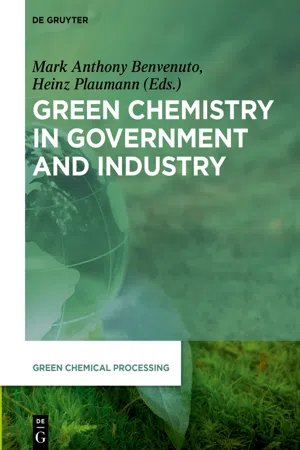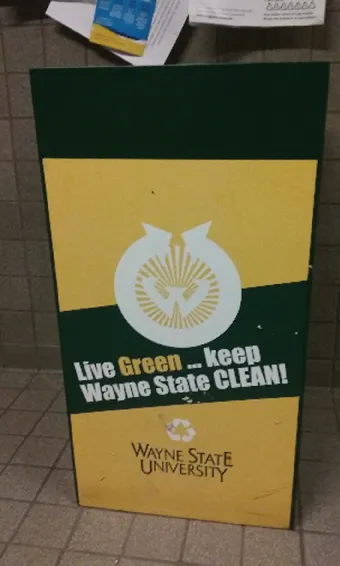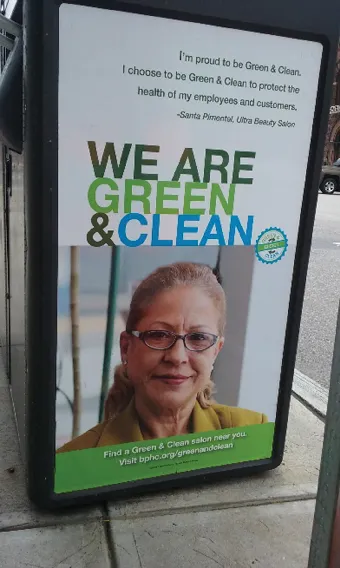
eBook - ePub
Green Chemistry in Government and Industry
Mark Anthony Benvenuto, Heinz Plaumann, Mark Anthony Benvenuto, Heinz Plaumann
This is a test
- 144 pagine
- English
- ePUB (disponibile sull'app)
- Disponibile su iOS e Android
eBook - ePub
Green Chemistry in Government and Industry
Mark Anthony Benvenuto, Heinz Plaumann, Mark Anthony Benvenuto, Heinz Plaumann
Dettagli del libro
Anteprima del libro
Indice dei contenuti
Citazioni
Informazioni sul libro
The 5 th volume of Green Chemical Processing considers sustainable chemistry in the context of governmental and corporate interests, explaining how "red tape" can help or hinder the "greening" of industry processes. The American Chemical Society's 12 Principles of Green Chemistry are woven throughout this text as well as the series to which this book belongs.
Domande frequenti
Come faccio ad annullare l'abbonamento?
È semplicissimo: basta accedere alla sezione Account nelle Impostazioni e cliccare su "Annulla abbonamento". Dopo la cancellazione, l'abbonamento rimarrà attivo per il periodo rimanente già pagato. Per maggiori informazioni, clicca qui
È possibile scaricare libri? Se sì, come?
Al momento è possibile scaricare tramite l'app tutti i nostri libri ePub mobile-friendly. Anche la maggior parte dei nostri PDF è scaricabile e stiamo lavorando per rendere disponibile quanto prima il download di tutti gli altri file. Per maggiori informazioni, clicca qui
Che differenza c'è tra i piani?
Entrambi i piani ti danno accesso illimitato alla libreria e a tutte le funzionalità di Perlego. Le uniche differenze sono il prezzo e il periodo di abbonamento: con il piano annuale risparmierai circa il 30% rispetto a 12 rate con quello mensile.
Cos'è Perlego?
Perlego è un servizio di abbonamento a testi accademici, che ti permette di accedere a un'intera libreria online a un prezzo inferiore rispetto a quello che pagheresti per acquistare un singolo libro al mese. Con oltre 1 milione di testi suddivisi in più di 1.000 categorie, troverai sicuramente ciò che fa per te! Per maggiori informazioni, clicca qui.
Perlego supporta la sintesi vocale?
Cerca l'icona Sintesi vocale nel prossimo libro che leggerai per verificare se è possibile riprodurre l'audio. Questo strumento permette di leggere il testo a voce alta, evidenziandolo man mano che la lettura procede. Puoi aumentare o diminuire la velocità della sintesi vocale, oppure sospendere la riproduzione. Per maggiori informazioni, clicca qui.
Green Chemistry in Government and Industry è disponibile online in formato PDF/ePub?
Sì, puoi accedere a Green Chemistry in Government and Industry di Mark Anthony Benvenuto, Heinz Plaumann, Mark Anthony Benvenuto, Heinz Plaumann in formato PDF e/o ePub, così come ad altri libri molto apprezzati nelle sezioni relative a Scienze fisiche e Scienze ambientali. Scopri oltre 1 milione di libri disponibili nel nostro catalogo.
Informazioni
1 It’s not easy becoming Green … but we’re getting there!
Heinz Plaumann
Department of Chemistry & Biochemistry, University of Detroit Mercy, Detroit, MI, USA
Mark A. Benvenuto
Department of Chemistry & Biochemistry, University of Detroit Mercy, Detroit, MI, USA
Abstract
This volume contains contributions from a very diverse group, starting with a former president of American Chemical Society, and with members in industries including a leading grocery chain in the United States mid-west, technical experts in the transportation industry, and including academia and government agencies. We look forward to the growing momentum in greening our world with ongoing progress in this growing and evolving series.
Keywords: green chemistry in industry, plastics, green chemistry in automotive, chemistry and lumber,
1.1 Introduction
“It’s not easy being Green” proclaimed Muppet superstar Kermit the Frog in the iconic song, but this volume teaches that we are indeed getting better at it. What might be called “The Parade” is growing and gaining momentum. Figure 1.1 and Figure 1.2 show examples of efforts designed to make our society greener, and at the same time raise awareness of the issue.

Figure 1.1: Garbage receptacle at a university proclaims the green chemistry theme.

Figure 1.2: A U.S. beauty salon chain markets their support to environmental concerns.
This fifth volume again includes contributions from a distinguished list of authors, covering a diverse range of topics. Any reader with a curious bent will be cerebrally stimulated by the topics, their relevance, and the range of writing styles. Many Green Chemistry thrusts have been directed in three broad areas: transportation, energy sources, and the problem of disposal. These might now be considered the usual “3 Rs” – Reduce, Reuse, Recycle. With the following brief chapter summaries, let us whet your appetite to consume and then digest what we hope can be called this delightful volume.
1.2 This volume
The chapters in this volume will indeed enlighten the reader to how broadly the principles of green chemistry are being applied. The greening of our chemistry, indeed our science and our world is necessary. Enjoy these many diverse examples as “role models”, challenges, and encouragement.
1.2.1 Biodegradable polymers – why, what, how?
We are honored to have Dr Attila Pavlath as the distinguished author of this volume’s lead chapter. A former president of the American Chemical Society, his career has included a broad range of contributions to the chemical enterprise – including the holder of many patents, winner of many awards, author of numerous technical articles and books, long-time professor, now emeritus. Many have said the curious mind, needs to know, and Dr Pavlath’s life’s passion has been the pursuit of knowledge to share with Humanity. His timely chapter here is of considerable import.
Polymers are ubiquitous and have contributed much to our current quality of life, be it in areas such as transportation, energy, medicine, recreation, construction. In truth, there is no current human endeavor untouched by some polymeric influence. In this excellent expose “Biodegradable Polymers: Why, What, How?” Dr Pavlath walks us through from the synthesis craze in the twentieth century to tailor-making polymers to meet specific properties, and how we are now burdened somewhat with the backdrop of, “from cradle … to now what?”. Clearly, a strong and obvious focus is the trend to design biodegradable polymers to be “yummy bug-food” to facilitate their decomposition. Many examples and references make this a worthwhile read as well as a reference source.
1.2.2 Sustainable materials in automotive
Dr Rose Ann Ryntz holds a Ph.D. from the University of Detroit and an M.B.A. from the University of Michigan. Her academic qualifications however pale in contrast with being a true cornerstone in the transportation industry where she has contributed to the commercial success of several companies. She has received many awards from such groups as the Society of Plastics Engineers, the American Chemical Society, and the Engineering Society of Detroit, to mention only a few. She and her co-author Susan Kozora are with the International Automotive Components Group.
The contribution of Dr Ryntz to this volume reviews the breadth of polymeric materials in this industry, with introduction to specific materials, the properties which render them useful, and their ultimate fate – be it recycling or repurposing. They also include a superb section on legislative issues along with sustainability issues in the industry. An excellent section about bio-based versus recycled materials is truly thought provoking.
1.2.3 Meijer and carbon management
Dr Erik Petrovskis holds a Ph.D. in Environmental Engineering from the University of Michigan and has been a lecturer there. He has over twenty years of experience as an environmental consultant and serves as Director of Environmental Compliance and Sustainability for Meijer. His co-author, Christina Britton, holds a MS in Environmental Policy from Bard College and is a Sustainability Analyst for Meijer.
Meijer is a family-owned retailer in the Midwestern United States. The 84-year-old company has always lived by its commitment to environmental concern. It currently operates over 240 stores in six states with its concomitant carbon-footprint from heating, refrigeration, lighting and supply chain/logistics. Erik and Christina present these challenges and how Meijer has dealt with them in exemplary fashion – an excellent model for other industries.
1.2.4 Applying green chemistry approaches to EPA-standard method of analysis of dioxins
Susan Walkinshaw is an analytical expert with the EPA, and her chapter clearly and eloquently speaks to this, comparing a number of different extractions methods to recover specific target molecules for analysis. The journey begins with a problem statement, selection of method, sample preparation and solvent considerations. The analysis includes discussion of the hazards of the various solvent options along with their respective costs.
1.2.5 Green routes to silicon-based materials and their environmental implications
Dr Joseph Furgal received his Ph.D. in Materials Chemistry at the University of Michigan and is now an assistant professor at Bowling Green University. His co-author Dr Chambika Lenora holds a Ph.D. in inorganic chemistry from Wayne State University.
They start their contribution by indicating that “silicon based materials have their origins in the Stone Age” with quartz and other rocks to make the first tools. Their historical treatment covers the first reported interactions of silicon and carbon in the late 1800s leading to the development of natural rubber replacements with silicone rubbers during the 1930s and 1940s.
Silicon-based materials play very important roles in numerous industries, but especially in the computer and related chip industries. A significant contributor to “greening” this industry has been the conversion of the bio-based raw material (specifically rice hull ash) into useful silicon building blocks rather than the low reactivity mined silica sources.
1.2.6 Greening within the lumber industry
The lumber industry is among those cornerstone industries which have not been under the same “green scrutiny” as many others, as Ms Ruby Wong indicates, “having gone on for centuries without any indication of environmental consciousness”. Dr Wong holds a B.S. Degree in Biological Chemistry from the University of Detroit Mercy and has almost a decade of experience directing and working in research labs in materials science, environmental and regulatory compliance, quality control, quantitative analysis, and green chemistry.
She describes the industry from “the ground up” – planting, nurturing and harvesting, and includes trends in forest coverage on Earth, plant hybridization, degradation and decay, and reforestation, all with a view to environmental impact, carbon footprint, and energy impact. Sawing, drying, planning and subsequent processing are also discussed. The entire chapter is a very refreshing and enlightening view.
1.2.7 Determining wildland fire markers in residential structures using thermal desorption gas chromotography mass spectrometry
One artifact of our on-going climate changes appears to be the increased frequency and intensity of wildland fires with considerable damage and cost to residential and commercial property. Presently there are no specific industry standards or guidelines for analyzing the resulting combustion residues. In this chapter, Professor Dale LaCaptain, K. Martin, and A. Delia summarize some of these events, and their results with directed focus upon method development for analysis.
1.3 Summary
We do recommend anyone who is interested in what we have presented here to please examine the previous volumes in this series as well, to see who has authored chapters in them, and what subjects have been covered. As this series continues to expand, we welcome discussions about ideas for future volumes with an eye to welcoming your contribution. If you are interested, please contact us.
Indice dei contenuti
- Title Page
- Copyright
- Contents
- 1 It’s not easy becoming Green … but we’re getting there!
- 2 Biodegradable polymers: Why, what, how?
- 3 Sustainable materials in automotive
- 4 Meijer and carbon management
- 5 Applying green chemistry approaches to EPA standard method of analysis for dioxins
- 6 Green routes to silicon-based materials and their environmental implications
- 7 Green possibilities in a green industrial sector: The lumber industry
- 8 Determining wildland fire markers in residential structures using thermal desorption gas chromatography mass spectrometry
- Index
Stili delle citazioni per Green Chemistry in Government and Industry
APA 6 Citation
[author missing]. (2020). Green Chemistry in Government and Industry (1st ed.). De Gruyter. Retrieved from https://www.perlego.com/book/2107360/green-chemistry-in-government-and-industry-pdf (Original work published 2020)
Chicago Citation
[author missing]. (2020) 2020. Green Chemistry in Government and Industry. 1st ed. De Gruyter. https://www.perlego.com/book/2107360/green-chemistry-in-government-and-industry-pdf.
Harvard Citation
[author missing] (2020) Green Chemistry in Government and Industry. 1st edn. De Gruyter. Available at: https://www.perlego.com/book/2107360/green-chemistry-in-government-and-industry-pdf (Accessed: 15 October 2022).
MLA 7 Citation
[author missing]. Green Chemistry in Government and Industry. 1st ed. De Gruyter, 2020. Web. 15 Oct. 2022.